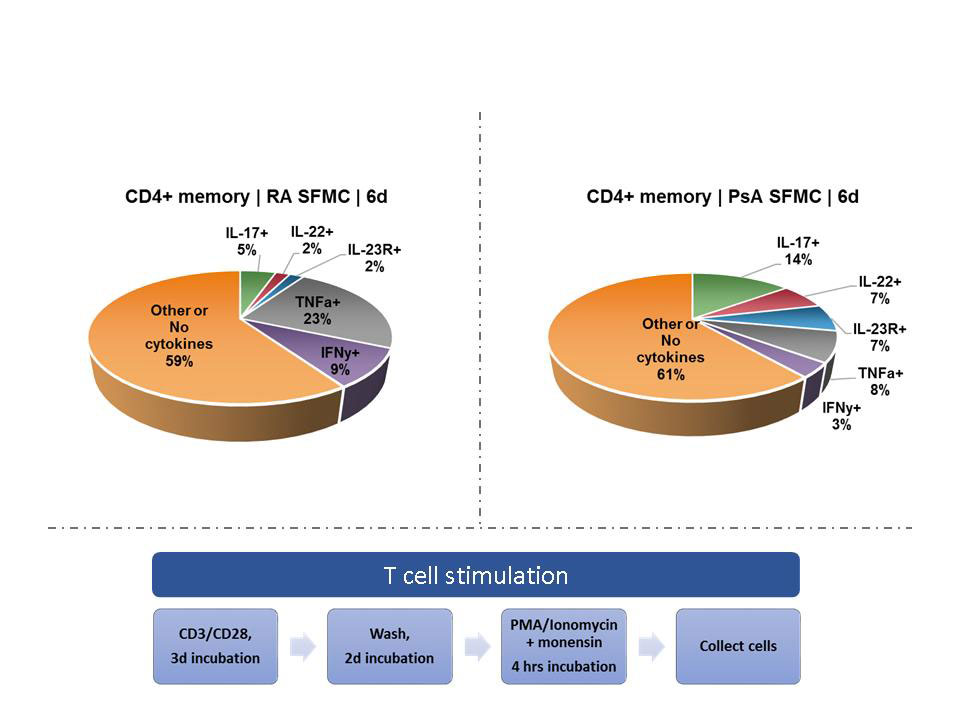Session Information
Session Type: Poster Session (Tuesday)
Session Time: 9:00AM-11:00AM
Background/Purpose: Importance to specific T cell subpopulations has been attributed for specific diseases such as Th17 cells in psoriatic disease, Th1 cells in TB and Th2 response for intracellular parasite infections. However, there are evidences that immune response is not a watertight condition for a specific T cell sub population. As a clinician, we notice this diversity too; a patient of psoriatic arthritis (PsA) may respond to an anti-TNF agent whereas anti-IL-17A may not work; a patient may respond to anti-IL-23 but fails anti-IL-17A or anti-TNF agents. Considering this background here we have addressed poly-functionality of the activated effector memory T cells as well the difference of poly functionality in T cells between individual autoimmune disease such as in PsA and rheumatoid arthritis (RA).
Methods: Peripheral blood (PBMC) synovial fluid (SFMC) mononuclear cells were collected from untreated PsA and RA (n=15/each) patients with active disease. Magnetically sorted CD3+ T cells were isolated from PBMCs and SFMCs; were activated (106 cells/ml) with anti-human CD3/CD28 cocktail and cultured in RPMI medium for 5 days (Fig 1). Hi-D FACS studies were performed to: (i) identify activated memory cells (CD3+CD4+CD45RO+) T cells (ii) identify the percentage of following Th1/Th17 cytokine profile: IL-17A, IL-22, TNFα, IFNy. The percentages of each cell population and the mean fluorescence intensity (MFI) were analyzed using Flow Jo software.
Results: We noticed a marked polyfunctionality in PBMC/SFMC T cells both in PsA and RA. SFMC T-cells exhibited greater cytokine polyfunctionality, compared with matched blood. In PsA SFMCs the number of IL-17A (7.5+0.4%), IL-22(6.4+0.3%) and IL-23R (6.5+0.%) secreting cells were significantly higher than the PsA PBMCs (3.8+0.3%, 1.1+0.5%, 1.2+0.7%, respectively; p< 0.001). Whereas % of TNFα T cells in PsA PBMCs (20.7+0.66) was higher than PsA SFMCs (8.16+0.11, p< 0.001); IFNy expressing cells in PBMCs and SFMCs were similar. RA SFMCs had significantly higher numbers of IL-17A (4.9+0.2%), IL-22 (2.5+0.1%), IL-23R (2.1+0.4%) and IFNy (24.3+0.2%) compared to RA PBMCs (1.8+0.%%, 0.8+0.2%, 1.0+0.5%, and 14.7+0.%% respectively, p< 0.001). RA PBMCs had higher numbers of TNFα secreting cells than RA SFMCs (15.8+0.5% vs 7.9+0.2%; p< 0.001).
Conclusion: Consistent to our and other reports we noticed activated CD4 memory T cells were the major source for these cytokines. Compared to RA (Fig 1), in PsA SFMCs significantly higher levels of IL-17A, IL-22 and IL-23R were noticed. In RA SFMCs the levels of TNFα and IFNγ were significantly higher- a trend towards a Th1 pattern. The study supports the common view that in PsA the T cells are more skewed towards Th17 cells. Probably that explains better efficacy for anti-IL-17A targeted therapy in PsA compared to RA. More intriguing result is that in both in PsA and RA the pathological T cells in the SF were vastly polyfunctional. It is expected the kinetics of the polyfunctionality and thus their cytokine profile would vary at different time point of the disease and this could be one possible explanation for variations for responsiveness or failure to a specific anti-cytokine therapy.
To cite this abstract in AMA style:
Raychaudhuri S, Raychaudhuri S. Diversity of Poly-Functional T Cells in Psoriatic Arthritis and Rheumatoid Arthritis and Its Therapeutic Significance [abstract]. Arthritis Rheumatol. 2019; 71 (suppl 10). https://acrabstracts.org/abstract/diversity-of-poly-functional-t-cells-in-psoriatic-arthritis-and-rheumatoid-arthritis-and-its-therapeutic-significance/. Accessed .« Back to 2019 ACR/ARP Annual Meeting
ACR Meeting Abstracts - https://acrabstracts.org/abstract/diversity-of-poly-functional-t-cells-in-psoriatic-arthritis-and-rheumatoid-arthritis-and-its-therapeutic-significance/

